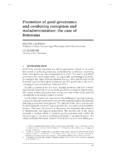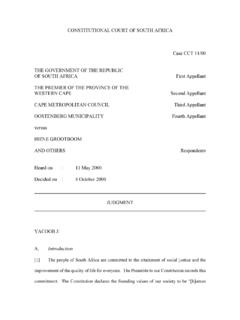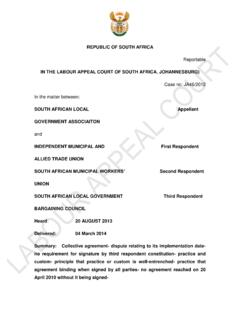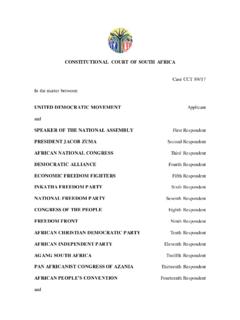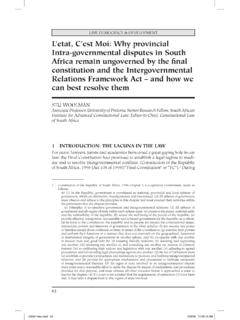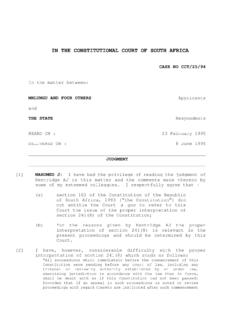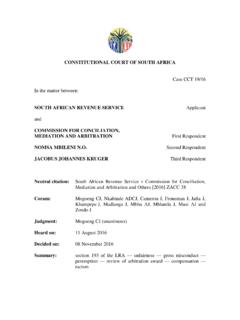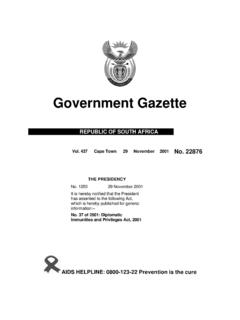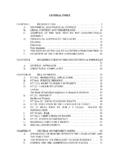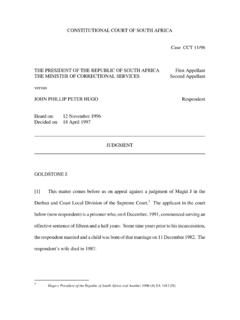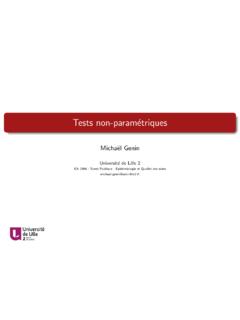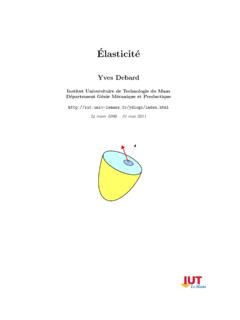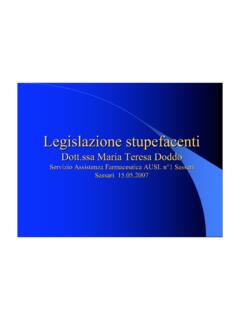Transcription of IN THE CONSTITUTIONAL COURT OF SOUTH AFRICA
1 IN THE CONSTITUTIONAL COURT OF SOUTH AFRICA CASE NO CCT 19/95 In the matter between: The STATE and WELLINGTON MBATHA and CASE NO. CCT 35/95 In the matter between: The STATE and NICOLAAS MARTHINUS PRINSLOO Heard on: 16 NOVEMBER 1995 Delivered on: 9 FEBRUARY 1996 JUDGMENT LANGA J: [1] Two matters come to this COURT by way of referrals from the Witwatersrand Local Division of the Supreme COURT . The accused in the first case is Wellington Mbatha who was tried and convicted in the Regional COURT at Germiston. Nicolaas Marthinus Prinsloo, an accused in the second matter, is standing trial in 2 the Witwatersrand Local Division with 25 others in the case of the S v Le Roux and Others.
2 I shall refer to the two accused persons as the applicants. [2] In the first matter, the applicant appealed against his conviction on two counts under the provisions of the Arms and Ammunition Act 75 of 1969 (the Act). The charge concerned the unlawful possession of two AK47 rifles and twelve rounds of ammunition, in contravention of sections 32(1)(a) and 32(1)(e) of the Act respectively. The sentences imposed, of eight and two years= imprisonment respectively, were ordered to run concurrently. On appeal, the matter was in turn referred to this COURT by Leveson J, with MacArthur J agreeing, for a decision on the constitutionality of the presumption contained in section 40(1) of the Act. [3] The twenty-six (26) accused in the second matter were indicted on various charges, 96 counts in all, arising out of a series of bomb explosions which took place before the national elections in April 1994.
3 After the close of the prosecution case, Flemming DJP refused an application for the discharge of all the accused on all counts. The applicant and six others were acquitted on all but four of the counts, namely, counts 80 to 83, which relate to the unlawful possession of machine guns, firearms and ammunition, in contravention respectively of sections 32(1)(a) and 32(1)(e) of the Act. In refusing to discharge the applicant on those remaining counts, the trial Judge stated that he relied solely on the presumption in section 40(1) of the Act. He then suspended the proceedings and made the referral order in terms of section 102(1) of the Constitution of the Republic of SOUTH AFRICA Act 200 of 1993 (the Constitution) on the basis that it was in the interests of justice that the issue be resolved at this stage of the proceedings.
4 The case has been postponed to 16 February 1996. [4] The issue in both matters is the validity of the presumption contained in section 40(1) of the Act in the light of the provisions of section 25(3)(c) and (d) of the Constitution. The applicants complain that the presumption offends against the >fair trial= provisions in the Constitution, in particular, the right to be presumed 3 innocent and the privilege against self-incrimination. Section 40(1) of the Act provides: Whenever in any prosecution for being in possession of any article contrary to the provisions of this Act, it is proved that such article has at any time been on or in any premises, including any building, dwelling, flat, room, office, shop, structure, vessel, aircraft or vehicle or any part thereof, any person who at that time was on or in or in charge of or present at or occupying such premises, shall be presumed to have been in possession of that article at that time, until the contrary is proved.
5 [5] The first comprehensive statute to regulate arms and ammunition nationally was the Arms and Ammunition Act 28 of 1937. Prior to this, each of the four provinces had their own acts regulating the possession and distribution of arms and ammunition. Section 32 of the 1937 Act provided: Any occupier of premises and any person who is upon or in charge of or who accompanies any vehicle, vessel or animal upon which or in which there is any article mentioned in section one or any arm or ammunition shall, until the contrary is proved, be deemed for the purposes of this Act to be the possessor of such article or arm as the case may be. The Orange Free State (Act 23 of 1908) and Transvaal (Act 10 of 1907) had substantially similar provisions.
6 Our courts, in an attempt to avoid obviously unintended results, interpreted the word Aoccupier@ in the 1937 Act strictly. Thus in S v Mnguni 1962(3) SA 662 (NPD) at 664D-E, the word was held to mean the person Awho is responsible for the premises and has the general control of them.@ It was held further that the word did not mean Aany person who is an occupant of premises@ because it was Aunlikely that the legislature would have deemed every person residing on the premises to be the possessor of arms.@ Section 40(1) of the present Act came into operation on 1 February 1972. The terms of the presumption are clearly wider in scope than those in the antecedent legislation, and now include not only occupants of premises but also persons Aon@, Ain@ or Apresent at@ such premises at any time when the Aarticle@ has been Aon@ or Ain@ such premises.
7 4 [6] Aspects of section 25(3)(c) and (d) of the Constitution have already been the subject of enquiry in some of the matters before this COURT in which their impact on statutory presumptions in our criminal law was considered. The relevant part of the section reads: Every accused person shall have the right to a fair trial, which shall include the right .. (c) to be presumed innocent and to remain silent during plea proceedings or trial and not to testify during trial; (d) to adduce and challenge evidence, and not to be a compellable witness against himself or herself .. [7] In S v Zuma and Others 1995(2) SA 642(CC); 1995(4) BCLR 401(CC), the issue was the constitutionality of a legal provision contained in section 217(1)(b)(ii) of the Criminal Procedure Act 51 of 1977 which placed a burden on the accused to rebut a presumed fact, namely, that a confession had been made freely and voluntarily.
8 The phrase Aunless the contrary is proved@ which was used in the provision meant, in effect, that if the accused failed to discharge the burden of proof, that is, on a balance of probabilities, the confession would be admitted notwithstanding the existence of a reasonable doubt that it had been made freely and voluntarily. (See Ex Parte Minister of Justice: In re: R v Jacobson and Levy 1931 AD 466 at 471; Ex parte Minister of Justice: In re: R v Bolon 1941 AD 345 at 360 - 361; S v Mphahlele and Another 1982 (4) SA 505 (A) at 512C). Sections 25(2) and 25(3)(c) and (d) of the Constitution entrench as a fundamental CONSTITUTIONAL value the fact that it is the duty of the prosecution to prove the guilt of an accused person in a criminal case.
9 As Kentridge AJ at paragraph 25 pointed out, Athe presumption of innocence is derived from the centuries-old principle of English law, forcefully restated by Viscount Sankey in his celebrated speech in Woolmington v Director of Public Prosecutions (1935) AC 462 (HL) at 481, that it is always for the prosecution to prove the guilt of the accused person, and that the proof must be proof beyond a reasonable doubt.@ The rights to be presumed innocent, to remain silent during trial and not to be a compellable witness against oneself are entrenched in sections 25(3)(c) and (d). CONSTITUTIONAL recognition of these rights in criminal trials means that statutory 5 erosion of these rights and principles can no longer be accepted without question as they were before this Constitution came into force; statutory presumptions and other legislation which adversely affect the rights entrenched in Chapter 3 of the Constitution will now have to meet the limitations criteria of section 33(1) of the Constitution.
10 (See S v Makwanyane and Another 1995(3) SA 391 (CC);1995(6) BCLR 665 (CC) at paragraphs 100 and 156; S v Williams and Others 1995(3) SA 632 (CC); 1995(7) BCLR 861 (CC) at paragraphs 8 and 54; S v Bhulwana; S v Gwadiso 1996(1) SALR 388 (CC); 1995(12) BCLR 1579 (CC) at paragraph 16.) This COURT held in Zuma=s case that the presumption of innocence was infringed by the provision which imposed an onus on the accused to disprove the voluntariness of the confession. [8] In S v Bhulwana; S v Gwadiso supra this COURT was concerned with a provision in Section 21(1)(a)(i) of the Drugs and Drug Trafficking Act 140 of 1992 which required that an accused who was proved to be in unlawful possession of dagga in excess of 115 grams be presumed, Auntil the contrary is proved,@ to be dealing in such dagga.
